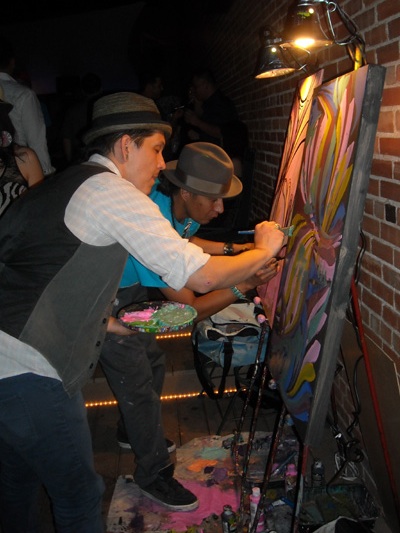Syncretize, Decolonize: First Nations Find a Voice Through Urban Music and Dance
It was a Thursday night in Albuquerque, discount NM, and on the floor of a small club on the outskirts of town a member of the Foundations of Freedom dance crew drew applause from onlookers. With his synthesis of moves culled from breakdance and traditions far older, the dancer transitioned from handspins to a kneeling archer’s position in one fluid motion. When the song – itself a hybrid of house and powwow music – finishes, the dancer straightened his shirt emblazoned with the image of a Playboy bunny sporting eagle feathers in place of ears.
A Tribe Called Red comprised some of the music at the event. The group, which emerged out of Canada in 2008, synthesizes powwow music and electronica into a genre known as “Powwow Step.”
The club was packed with people predominately from New Mexico’s 19 Pueblos and from the Navajo (Diné) nation. Those who turned out were clad in intricately beaded jewelry, hand-painted Chucks and witty T-shirts which nodded to pop culture or made parody and political statement out of the stereotypes that so many non-indigenous Americans ascribe to when it comes to native peoples.
The party was one among dozens of music, art and fashion events surrounding the Gathering of Nations powwow held every April in Albuquerque, NM, where more than 50,000 individuals from more than 500 nations come to dance, sell their wares and mingle. But for most of those in the club that night, the powwow itself wasn’t the main event.

Patrick CloudFace Burnham (foreground) and Randy Barton create live paintings at a Gathering of Nations after party.
In fact, for many it represented just another means for non-natives to exploit native people. And while some would go to support friends and family, others declared the event fodder for the colonized and instead chose to attend native-organized counter powwows and Sacred Cyphers where musicians, painters and dancers could express themselves in their own spaces through a fusion of native song, hip hop and electronic dance.
Extended footage of the Sacred Cypher following Gathering of Nations 2012. At 4:45 the syncretism becomes especially apparent.
But why the fusion of various native and urban dance cultures, specifically, why hip hop? Why not create something completely new?
For some, the explanation is straightforward. “I think a lot (of natives) can relate to the plight of hip hop artists and rappers,” said Simon Moya Smith, Oglala Lakota and creator of I Am Not a Mascot. “They can comprehend being subjugated and the hard knock life and it’s about appropriating what they can comprehend.”
Still for others, hip hop music and dance are merely one of many platforms upon which traditions can be upheld and expressed in a modern context. “We express our blessings and our passion in dance,” said Roy Leo Lee III, a Diné B-Boy with Foundations of Freedom. “It’s how we cleanse.”

Roy Leo Lee III takes in the air at a live graffiti installation featuring native street artists in Santa Fe, NM.
But perhaps most of all, hip hop is an accessible way to bring attention to very real issues within native communities and provide an outlet for these to be expressed and combated.
Take for example the ongoing struggle to obtain water rights for those living on the Navajo reservation. According to a 2010 study conducted by the EPA, in an area larger than Ireland and home to more than 200,000 individuals, more than a third have no access to clean water due largely to restrictions the U.S. Government has placed upon the Diné regarding where and how much water can be taken within the boundaries of their own land.
It was at the Sacred Cypher which marked the end of this year’s Gathering of Nations that BMedia shot the following footage which features some insight from Foundations of Freedom Founder Randy Barton regarding how native song, dance, hip-hop and social activism converge:
In this context the classic themes of resistance and unity upon which hip hop was founded couldn’t be more relevant. By syncretizing these with the values and traditions of native culture, a new generation finds a voice that carries long after the deejay has packed up and headed home.

October 8th, 2012 at 5:01 pm
[…] douchebag writers in movies. We enjoyed Pete Souza’s portrait of a Presidency. We explored modern native art and culture, and listened to Powwow-Step. We watched a documentary about fan films. We discovered an exhibition that tackles Asian […]
October 9th, 2012 at 8:24 am
“never trust a spiritual leader who cannot dance” so much YES!!!
Living in the southwest it’s really strange to see and experience how much native cultures are simultaneously fetishized and consistently disenfranchised. it’s up to us to define and empower ourselves!! awesome post!!
October 9th, 2012 at 3:12 pm
sweet post!
February 4th, 2013 at 9:51 pm
We are not moving fast enough with resolutions. I am amazed as the number of vehicles on the road with only one occupant. Better green mass transit is badly needed. Corporations must extinguish their old ideas and accept the practice of telecommuting, which is a win win for all (less cars on the road, improved morale and the savings in corporate real estate taxes and maintenance cost. I can go on and on, but the bottom line is that we are not moving fast enough and our children will suffer the consequence of our timid behavior.